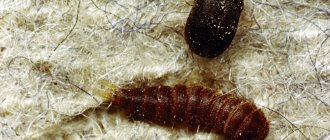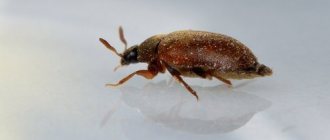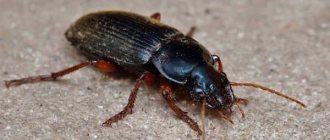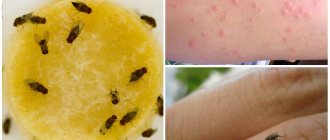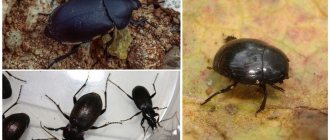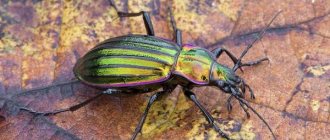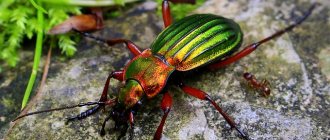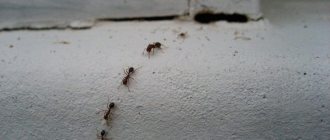Few people know about such a parasite as the carpet beetle, so few know how to get rid of skin beetle. People know firsthand parasites like cockroaches, bedbugs and rats. But who is the carpet beetle? How is it dangerous for humans?
How to get rid of skin beetle
This bug infests in residential buildings, museums, hotels, and shops. Its food source is leather, fur, and wool products. The carpet beetle is not averse to eating cheese, meat, and grain. Therefore, the reproduction of these parasites can lead to the destruction of food, clothing, bags, and shoes.
Prices for pest control for individuals
Conventional drugsPrice1 room apartment One-time price Cold fog (ULV irrigation) from 1800 rubles Cold fog and barrier protection from 2700 rubles Hot fog (GAP treatment) from 4500 rubles Comprehensive treatment with hot and cold fog, barrier protection as a gift from 5900 rubles Comprehensive treatment with hot and cold fog, barrier protection as a gift + PPE (personal protection system) from RUB 7,400 2-room apartment Single price Cold fog (ULV irrigation) from RUB 2,100 Cold fog and barrier protection from RUB 3,100 Hot fog (GAP treatment) from RUB 4,700 Complex treatment hot and cold fog, barrier protection as a gift from 6,400 rubles. Complex treatment with hot and cold fog, barrier protection as a gift + PPE (personal protection system) from 7,900 rubles. 3-room apartment One-time price Cold fog (ULV irrigation) from 2,300 rubles. Cold fog and barrier protection from RUB 3,300. Hot fog (GAP treatment) from RUB 4,900. Comprehensive hot and cold fog treatment, free barrier protection from RUB 6,800. Comprehensive hot and cold fog treatment, free barrier protection + PPE (personal protection system) from RUB 8,300. .Premium drugsPrice1 room apartment One-time price Cold fog (ULV irrigation) from 3800 rubles Cold fog and barrier protection from 4700 rubles Hot fog (GAP treatment) from 6500 rubles Comprehensive treatment with hot and cold fog, barrier protection as a gift from 7900 rubles Comprehensive treatment with hot and cold fog, barrier protection as a gift + PPE (personal protection system) from RUB 9,400 2-room apartment Single price Cold fog (ULV irrigation) from RUB 4,100 Cold fog and barrier protection from RUB 5,100 Hot fog (GAP treatment) from RUB 6,700 Complex treatment hot and cold fog, barrier protection as a gift from 8,400 rubles. Complex treatment with hot and cold fog, barrier protection as a gift + PPE (personal protection system) from 9,900 rubles. 3-room apartment One-time price Cold fog (ULV irrigation) from 4,300 rubles. Cold fog and barrier protection from RUB 5,300. Hot fog (GAP treatment) from RUB 6,900. Comprehensive hot and cold fog treatment, free barrier protection from RUB 8,800. Comprehensive hot and cold fog treatment, free barrier protection + PPE (personal protection system) from RUB 10,300. .Carpet beetles like to build their nests in warm and dry places. A favorite place is a closet with clothes, the space near radiators, upholstered furniture. The female lays eggs in hard-to-reach places, where people rarely clean. It’s worth figuring out how to get rid of skin beetles.
How to get rid of skin beetle
How to find them?
Carpet beetles are known to hide in the dark and in secluded areas of your home.
Many people confuse them with bedbugs, and they also infest beds by feeding on dead skin cells and sheets.
However, unlike bedbugs, they do not bite you. They will irritate your skin, especially if you have an allergic reaction to them.
However, they don't bite. At worst, you will most likely develop bite-like marks on your skin if you ever come into contact with these carpet beetles.
However, they eat fabrics in your home, so if you find damage in your linens and sheets, then you most likely have bark beetles in your home.
However, unlike moths, they feed on one piece of tissue at a time. So the damage will be large and isolated holes in your fabric.
As they feed, they shed their skin to continue growing. Faded skin is often translucent and flaky. They often shed their skin in the same area where they feed.
How to get rid of the carpet beetle?
After detecting a skin beetle, you need to start fighting as soon as possible. The first step is to vacuum all the carpets and carry out a wet general cleaning of the entire room. Move the furniture aside and go over all corners with a cloth. This will create uncomfortable conditions for the parasite: moisture and cold. Then you need to buy lavender essential oil and treat the closets where clothes and shoes are stored. Carpet beetles do not like strong odors, so lavender and wormwood are a good way to drive away parasites. Leather shoes, bags, and clothes need to be treated with boron powder. Apply a small amount of powder to a sponge and rub it into the surface of the product. Boric acid has a negative effect on many domestic parasites and skin beetles are no exception.
Prices for traveling outside the Moscow Ring Road | |
| Distance from MKAD | Departure cost |
| up to 20 km. | 500 rub. |
| from 20 to 50 km. | 800 rub. |
| from 50 to 80 km. | 1200 rub. |
| from 80 to 100 km. | 1700 rub. |
| from 100 to 120 km. | 2200 rub. |
| from 120 to 180 km. | 3000 rub. |
| from 200 km. | 3000 +1500 rub. (accumulation). |
How to get rid of the skin beetle
If you don’t know how to get rid of the skin beetle, then you can purchase special sticky traps. If all these methods do not help, you can buy special chemicals - insecticides. They are sold in the form of sprays, powders, and sheets. The spray needs to be applied to all hard-to-reach places, the space behind the baseboards, under carpets and furniture. In the wardrobe you can hang plates soaked in insecticide; they are used to kill moths, but they also repel bark beetles. In the event that you have tried all the remedies and still do not get rid of the skin beetle, it’s time to seek help from professionals who will help you get rid of the skin beetle forever.
SES contacts for Moscow districts:
Ways to fight in an apartment
Before choosing a method of dealing with skin beetles and starting to fight them, you need to find their location. If you manage to find a cluster of leather beetle eggs, it is a huge success. Look under the carpet, under the baseboard. Most often, the larvae of the leather beetle settle there. During the period of struggle, it is necessary to vacuum the apartment several times a day. These manipulations will reduce the horde of eggs and larvae, but will not completely rid you of this scourge.
There are inexpensive methods of control, for example, freezing. In winter, you can freeze your apartment; these insects die at temperatures below 10 degrees. To be sure, repeat this procedure. You can treat furniture with steam, and soak clothes and bedding in hot water or boil. If these methods do not give you the desired results, then it is time to move on to chemicals.
- Boric acid powder. Powder preparations are rubbed in with a brush or simply sprinkled on the areas where pests have been noticed. Treat the baseboards and crevices, if any, with boric acid, and distribute the powder under the carpet. Boric acid is not dangerous to humans and has no odor.
- Treating wool and fur items with a weak solution (0.005%) of the pyrethroid permethrin will save you not only from the skin beetle, but also from clothes moths for a year.
- Special aerosols: Dichlorvos, Reid, Chlorophos, Raptor. To completely get rid of parasites, use the aerosol in several approaches.
- Aqueous concentrated suspensions. These products can be purchased at a specialty store. They are used in case of severe infection.
- Fumigants or tablets. For example, “Antimol”, but an adult will not take this method, but the larva will gladly swallow the tablet.
Aphids on roses: 7 effective methods to combat them
Destruction of skin beetles in three steps
In the most general case, the destruction of skin beetles is carried out according to the following plan:
- All places where leather beetles hide, breed and feed are searched and opened. This is the most difficult stage, because due to their phenomenal omnivorous nature, these bugs with their larvae can safely exist, grow and reproduce almost anywhere.
- Places where insects accumulate are treated with insecticides.
- Additionally, with preparations with a long residual effect, places where either adult beetles or larvae were regularly encountered, but where they are not permanently present, are treated. Here the calculation is made on the fact that insects that are not in places of accumulation and that can survive the treatment can move along these surfaces. Having come into contact here with a drug with a long residual effect, the insects will die, albeit later than the main part poisoned directly.
Here in the photo, for example, beetles collected in the apartment after disinfestation:
With professional disinfestation, the third stage is not needed - in the second step, all surfaces and possible hiding places of skin beetles are sprayed so intensively that they all die. Even if some individuals survive such baiting, with the slightest subsequent movements they will end up on a layer of the drug, which will remain in those places where the owners of the apartment, even with thorough cleaning, will not be able to remove it - behind the baseboards, on the back walls of furniture, under floor covering. And all these surviving characters will die. Although, according to our observations, no surviving skin beetles remain indoors after proper treatment with professional products.
Let's now go through each point in order.
Liquid GET Total
GET Total is a pesticide that effectively kills skin beetles. The active ingredient of the drug is chlorpyrifos - a strong insecticide that affects the nervous system of the insect. The drug is diluted in water in a ratio of approximately 1:10, and then sprayed in a dense layer on the surface of objects and on the floor. It can be used both indoors and on the porch, veranda, steps of a private house and beyond. After spraying the product, the water dries naturally and microcapsules remain, which will fight pests. These capsules are resistant to humidity, temperature changes and sunlight, so GET Total can be used in almost any conditions. In this case, no visible marks remain on the surfaces. The drug is sold in 100 ml bottles. and costs about 1000 rubles. As a rule, the consumption rate is 100 ml. for an absorbent surface and half as much for a non-absorbent one. An important advantage of GET Total is that it is harmless to people and pets. It has the fourth, lowest hazard class. Important! It acquires this class only after drying, so work with gloves and while spraying, remove small children, animals and anyone to whom you cannot clearly explain the dangers of the insecticide from the room. The drug has a very slight odor and the aroma quickly disappears. If you are not allergic to any scents, GET Total will not be a cause for concern.
Buy the drug
What damage can beetles cause?
So, you have a skin beetle. Why is such a “neighbor” dangerous and how to get rid of it? First of all, leather beetles destroy all things made from materials of animal origin: fluff, leather, fur, felt, silk, wool and others. They also love to chew on food products: dried and dried meat and fish, cheese, milk and cereals. Then they will not disdain books, especially old ones. Their bindings contain glue, which they also “respect” very much.
In particularly advanced cases, skin beetles can harm wires and cables, for example from a computer, chew furniture, especially upholstery, picture frames, “eat” wallpaper, especially natural wallpaper, and chew parquet.
Prevention of the appearance of surviving bugs and their larvae
In most cases, after baiting, individual beetles, and especially the smallest larvae, almost invisible to the naked eye, can survive in places where they were simply not found and not treated with an insecticide. They can safely remain here, lay eggs, or grow and pupate. And while they are in these inconspicuous places, no one will see them, and the owners of the apartment will think that they are not in the room. But either older larvae, which will exhaust food sources and will be forced to crawl away in search of new ones, or beetles, which will look for mating partners, will sooner or later get out of these shelters and begin to catch the eye.
Our experience
According to reviews and surveys of our clients, after disinfestation, no one encountered a single skin beetle in the house for 4 months. Of the 413 treatments that we carried out against these insects, 6 people (1.5%) met single individuals six months to a year after disinfestation, and it is impossible to say with confidence whether these were insects that survived the persecution, or new ones that entered the apartment after extermination. Be that as it may, in all six cases, single individuals were caught, which were easily destroyed by hand. There was no talk of any mass reproduction of skin beetles in the apartment after such persecution.
The photo below shows an unfolded litter with a whole cluster of skin beetle larvae:
At a minimum, to passively destroy them, it is enough to sprinkle all the cracks behind the baseboards, the joints of the edges of the flooring and the bottom of the walls in the room with some insecticidal powder. Hector or Ecokiller are suitable for this - they retain their effectiveness as long as they remain dry, and behind the same baseboards they will kill leather beetles a month, two, and six months after they are poured here.
It is enough to simply kill all the beetles that come into view after this, and the larvae with your own hands. After thorough baiting, there should not be many of them left in the room, and this way you can manually kill off all the surviving pests.
Preventive measures
To prevent skin beetles from infesting your apartment, it is worth periodically performing preventive measures. To do this, twice a year you need to go through all the things and clothes that are stored in closets. Old products are thrown away so that they do not linger.
As a preventive measure, it is allowed to use special tablets with the following odors:
- lavender;
- sagebrush;
- tansy;
- camphor;
- tobacco.
The leather beetle can cause enormous damage to property and the apartment itself. Accordingly, it is necessary to treat the premises using effective means. These can be special tablets or aerosols. If there are too many pests, you will have to call a disinfection service.
How to deal with the leather beetle
Interesting information
Getting rid of carpet beetles is not so easy, since their life activity includes some features. For example:
- Adults are active during the daytime, and in the evening they fly towards the light, so it is not difficult to fight them; it is enough to make primitive traps. As for caterpillars, this method is not suitable for destroying them.
- The larvae are afraid of sunlight, so they prefer to hide in dark, hard-to-reach places, which makes them difficult to find.
- These pests do not tolerate wet conditions, so regular wet cleaning helps to expel the carpet beetle from the apartment.
- Kozheed beetle larvae are more resistant to the action of special control agents compared to moths. Therefore, when destroying moths in an apartment, it is unlikely that you will be able to get rid of the skin beetle larvae.
- Caterpillars never rest and constantly move in search of food sources.
Skin beetle. Furry bugs in the apartment.
Appearance of the skin beetle
This beetle has a brown body 3 mm long. The insect reproduces quite quickly. So, one individual lays at least 20–30 eggs , from which larvae hatch within a month. It is worth noting that they are able to go without food for about 4 years. If there is enough nutrition, the skin beetle will turn into an adult in less than a year.
The main habitats of the pest are wetlands, dry areas and even apartments. Here the beetle is often found under baseboards, on window sills, as well as near radiators, in drawers and floor crevices.
Pests prefer to feed on carpets, fur items, various collections of insects, as well as other items made from any natural materials, including wool and leather. The diet includes fabric items and various grain crops.
Development and reproduction
To understand how long it can take to combat these pests, let's look at the stages of development of the leather beetle. Females can lay their larvae anywhere: on the surface of various materials, in cracks in the floor and walls, in furniture, and so on.
Depending on the room temperature, the period for the birth of a new population can range from two to fifty days. The drier and warmer the room, the faster the process goes. Each female is capable of laying about a hundred eggs during her life, and under the temperature and humidity conditions of an apartment, leather beetles can produce 4–5 offspring per year.
The larva of the leather beetle molts 6–7 times with an interval of 5–9 days, and before the pupation stage it can gnaw out long (up to 10 cm) passages even in those materials that are not used for food. Thus, it is the larvae that cause the greatest damage to the premises and people.
